Can you tell if there is dye in sapphires by sight alone? I recently had a seamen schepps sapphire and other gemstone bracelet appraised. The appraiser expressed that he felt some of the sapphire cabochons were replaced with dyed sapphires. This was done by shining a bright "torch" light into the sapphires and pointing to high color concentrations near the surface of the stone. I though a lab would be needed to determine this as it couldn't be done by sight alone.
You are using an out of date browser. It may not display this or other websites correctly.
You should upgrade or use an alternative browser.
You should upgrade or use an alternative browser.
Can you tell if there is dye in sapphires by sight alone?
- Thread starter broaria
- Start date
- Joined
- Jan 22, 2014
- Messages
- 6,538
Sapphires aren’t dyed as such, However they can be treated.
There is heat treatment only. This is very common it’s done to remove some of the rutile (silk) to make the sapphire more transparent.
There is heat with flux filling. Sometimes politely referred to as “with residues”. This isn’t a “good” treatment. Sapphires of low quality with surface reaching fissures (cracks) can made made to look much better and therefore look more Valuable. A glass filled / flux filled sapphire has very little value and should be avoided.
There is also Beryllium treated. This is done along with high heat and this improves the colour. This is like dyeing except it’s like a coating of better colour. Again it turns a low value sapphire into a sapphire that looks a lot better and therefore more valuable.
This treatment is not usually identifiable by sight alone (though there can be some indicators like concentration of colour along facet junctions).
Unless your jeweller has Gemology qualification he may not be accurate in identifying what he is seeing. Natural sapphires often have colour zoning. This is areas that have different intensities of colour.This is a natural process and occurs as the crystal grows (over millions of years). A gem cutter works with this natural phenomenon and the “better” tone it is often positioned near the table (top of the cut crystal) so that as you look down and admire the sapphire the colour appears more even and beautiful.
To be sure you would need to send the sapphire /s to a gem lab for a report. This isn’t cheap and usually it requires the sapphires to be assessed unmounted (that’s out of the setting).
There is heat treatment only. This is very common it’s done to remove some of the rutile (silk) to make the sapphire more transparent.
There is heat with flux filling. Sometimes politely referred to as “with residues”. This isn’t a “good” treatment. Sapphires of low quality with surface reaching fissures (cracks) can made made to look much better and therefore look more Valuable. A glass filled / flux filled sapphire has very little value and should be avoided.
There is also Beryllium treated. This is done along with high heat and this improves the colour. This is like dyeing except it’s like a coating of better colour. Again it turns a low value sapphire into a sapphire that looks a lot better and therefore more valuable.
This treatment is not usually identifiable by sight alone (though there can be some indicators like concentration of colour along facet junctions).
Unless your jeweller has Gemology qualification he may not be accurate in identifying what he is seeing. Natural sapphires often have colour zoning. This is areas that have different intensities of colour.This is a natural process and occurs as the crystal grows (over millions of years). A gem cutter works with this natural phenomenon and the “better” tone it is often positioned near the table (top of the cut crystal) so that as you look down and admire the sapphire the colour appears more even and beautiful.
To be sure you would need to send the sapphire /s to a gem lab for a report. This isn’t cheap and usually it requires the sapphires to be assessed unmounted (that’s out of the setting).
Sapphires aren’t dyed as such, However they can be treated.
There is heat treatment only. This is very common it’s done to remove some of the rutile (silk) to make the sapphire more transparent.
There is heat with flux filling. Sometimes politely referred to as “with residues”. This isn’t a “good” treatment. Sapphires of low quality with surface reaching fissures (cracks) can made made to look much better and therefore look more Valuable. A glass filled / flux filled sapphire has very little value and should be avoided.
There is also Beryllium treated. This is done along with high heat and this improves the colour. This is like dyeing except it’s like a coating of better colour. Again it turns a low value sapphire into a sapphire that looks a lot better and therefore more valuable.
This treatment is not usually identifiable by sight alone (though there can be some indicators like concentration of colour along facet junctions).
Unless your jeweller has Gemology qualification he may not be accurate in identifying what he is seeing. Natural sapphires often have colour zoning. This is areas that have different intensities of colour.This is a natural process and occurs as the crystal grows (over millions of years). A gem cutter works with this natural phenomenon and the “better” tone it is often positioned near the table (top of the cut crystal) so that as you look down and admire the sapphire the colour appears more even and beautiful.
To be sure you would need to send the sapphire /s to a gem lab for a report. This isn’t cheap and usually it requires the sapphires to be assessed unmounted (that’s out of the setting).
and @Bron357 thank you for your in-depth reply!
- Joined
- Jan 22, 2014
- Messages
- 6,538
That looks more like flux filling than beryllium treatment. It looks as if the fissures (cracks) have been filled in with coloured (blue) flux.
If you look closely at the surface of the sapphire, you will need some magnification (and on an angle so that the light source hits the facet) if there has been flux glass filling there will be telltale “spider veins” apparent. Like little squiggly lines across the surface. It’s through these surface reaching cracks that the Glass filling seeps in.
Beryllium treatment is more like a surface coating, the effect being a visually better colour.
A sapphire could be glass flux filled AND BE treated.
First photo is a cross section of a BE treated sapphire.
The second is a coloured glass filled quartz (same process Is used for corundum)
The third is also BE treated and as a side effect of such high heat, the natural rutile inclusions within the sapphire have “leached out” their titanium molecules creating a Sri gem blue “halo effect”.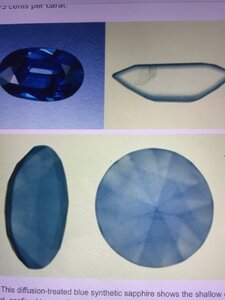
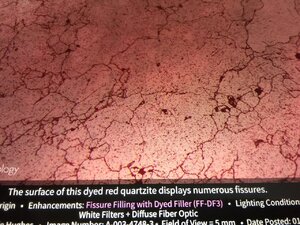
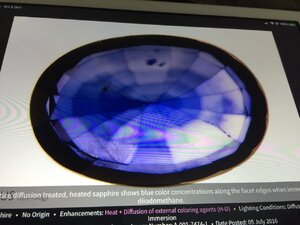
If you look closely at the surface of the sapphire, you will need some magnification (and on an angle so that the light source hits the facet) if there has been flux glass filling there will be telltale “spider veins” apparent. Like little squiggly lines across the surface. It’s through these surface reaching cracks that the Glass filling seeps in.
Beryllium treatment is more like a surface coating, the effect being a visually better colour.
A sapphire could be glass flux filled AND BE treated.
First photo is a cross section of a BE treated sapphire.
The second is a coloured glass filled quartz (same process Is used for corundum)
The third is also BE treated and as a side effect of such high heat, the natural rutile inclusions within the sapphire have “leached out” their titanium molecules creating a Sri gem blue “halo effect”.



Did You Miss the March 2024 Jewels of the Weeks?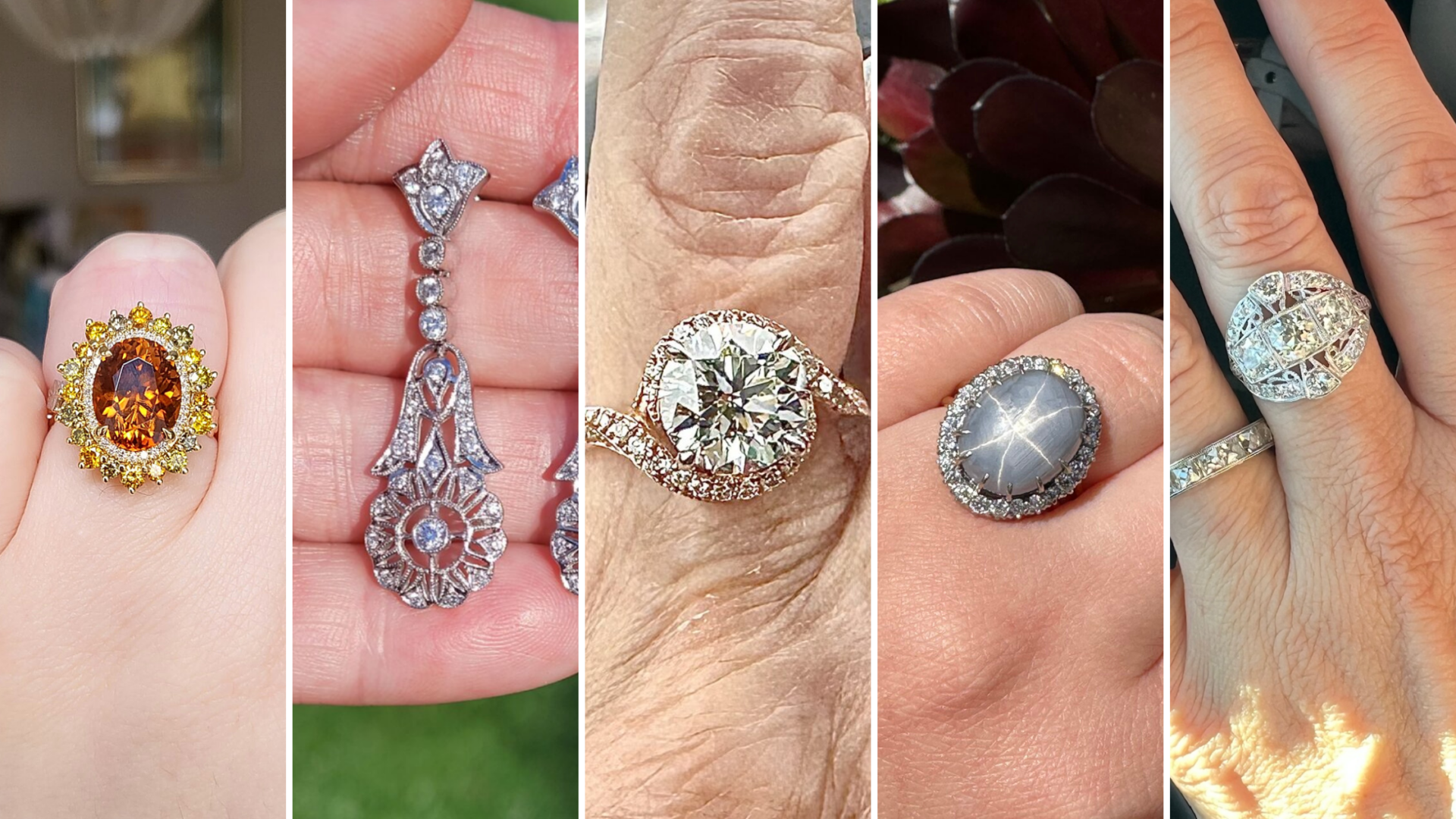 Did You Miss the March 2024 Jewels of the Weeks? - 03/30
Did You Miss the March 2024 Jewels of the Weeks? - 03/30

Did You Miss the Throwback Thursdays for March 2024?
Did You Miss the Throwback Thursdays for March 2024? - 03/28


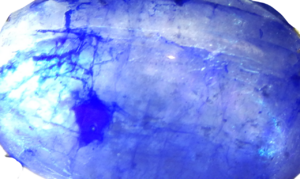

300x240.png)